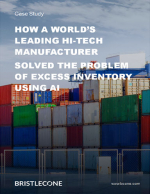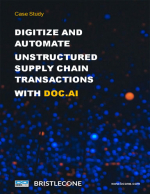Automotive Company Leveraged Machine Learning to Improve New Launch Forecast
Learn how an automotive aftermarket leader reduce forecast error from 111% to 55% in Year 1 for new product launches.
New Product launch decisions are critical to an organization's growth strategy. Particularly, for automotive aftermarket leaders for whom budgets of launching new parts can run into millions of dollars.
It is imperative that these strategic decisions pertaining to demand forecasts be made using data and not just a Product manager’s intuition. Each new variable must be thoughtfully weighed on several criterion –from market potential, failure rate, market saturation to pricing against the OEMs, among other things.
It was with the intention of overcoming the bottleneck of excess inventory for a new product launch that an automotive aftermarket leader reached out to Bristlecone.
Log in to download this paper.
What’s Related
Related Companies
Bristlecone
Related Topics
Risk Management
Artificial IntelligenceBristleconeDemand ForecastingInventory OptimizationMachine LearningRisk ManagementSupply Chain
All topics
News





Managing Supplier Risk in the Age of the Coronavirus
The coronavirus has infected countless people worldwide, surpassing the severity of the SARS outbreak but it also poses to significantly dent the global economy.
How to Digitize Your Supply Chain Without Losing Your Mind
How to Embrace the New Normal for Demand Planning
How Trace.ai Enhances Supply Chain Visibility
Fighting Billion-Dollar Weather and Climate Disasters with Sense.ai
More News
Resources

How a Biotech Manufacturer Leveraged AI, ML, and IoT to Gain Supply Chain Visibility
Learn how a biotech manufacturer leveraged Artificial Intelligence, Machine Learning & Internet of Things to attain visibility into 300,000+ annual shipments.

Hi-Tech Manufacturer Reduces Excess Inventory Using AI
Learn how a global producer of hi-tech semiconductors improved demand forecast accuracy by >40% and enabled better allocation of inventory.

Digitize and Automate Unstructured Supply Chain Transactions
Learn how a leading freight forwarder saved ~USD 1 million over 18 months and improved accuracy from 70% to almost a 100%.
More Resources
Favorites

How Does IKEA’s Inventory Management Supply Chain Strategy Really Work?
Each IKEA store is huge and holds more than 9,500 products! How in the world does IKEA offer so...

Starbucks as an Example of the Value Chain Model
The concept of value chain helps to understand and segregate the useful (which help in gaining a competitive...

7 Principles of Supply Chain Management Explained
Would you like to understand supply chain management concepts but don't have time to study from a textbook?...

Is Apple’s Supply Chain Really the No. 1? A Case Study
How Complex is Apple's Supply Chain? Some people in the blogosphere said that Apple's Supply Chain is not...

